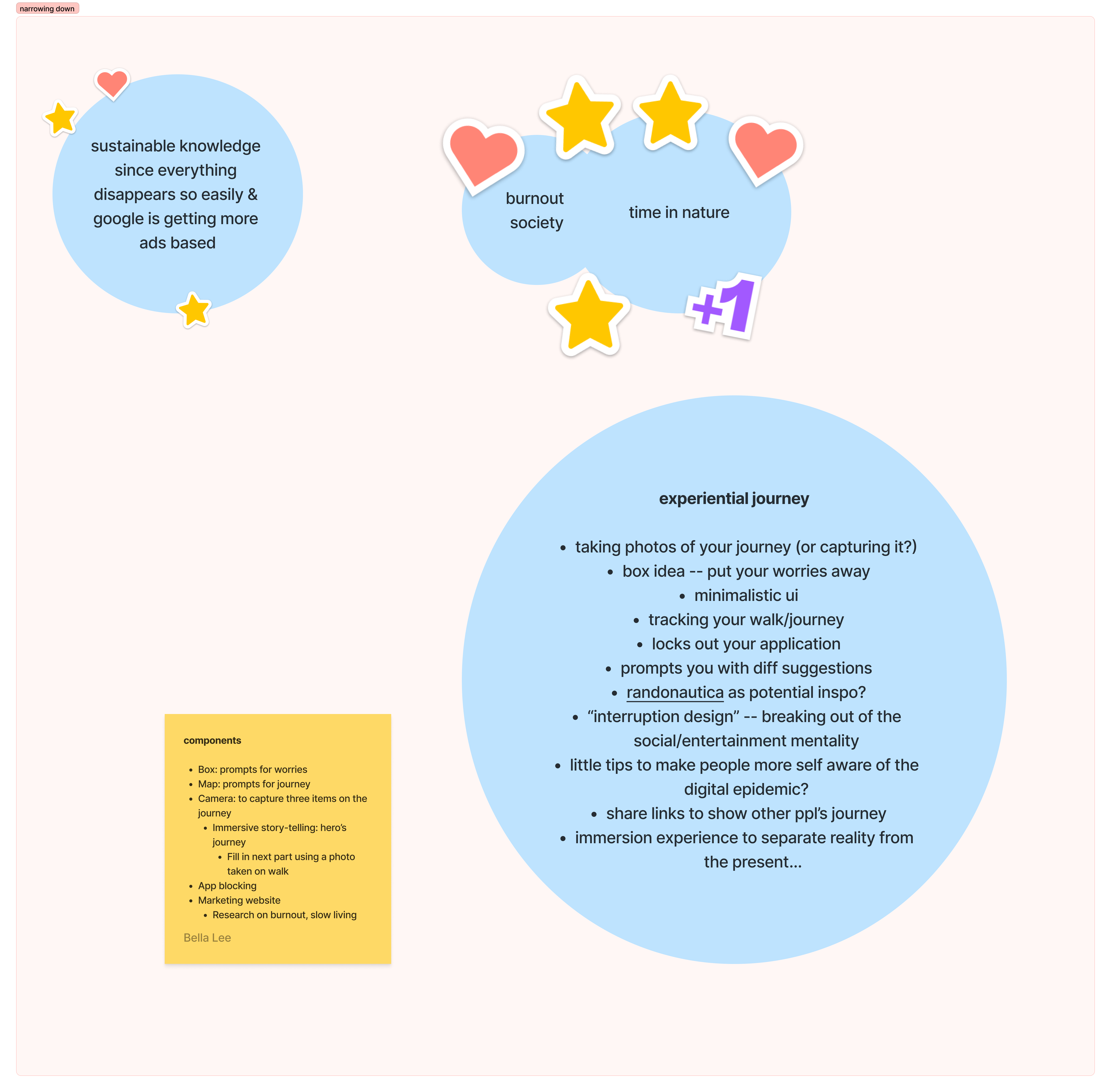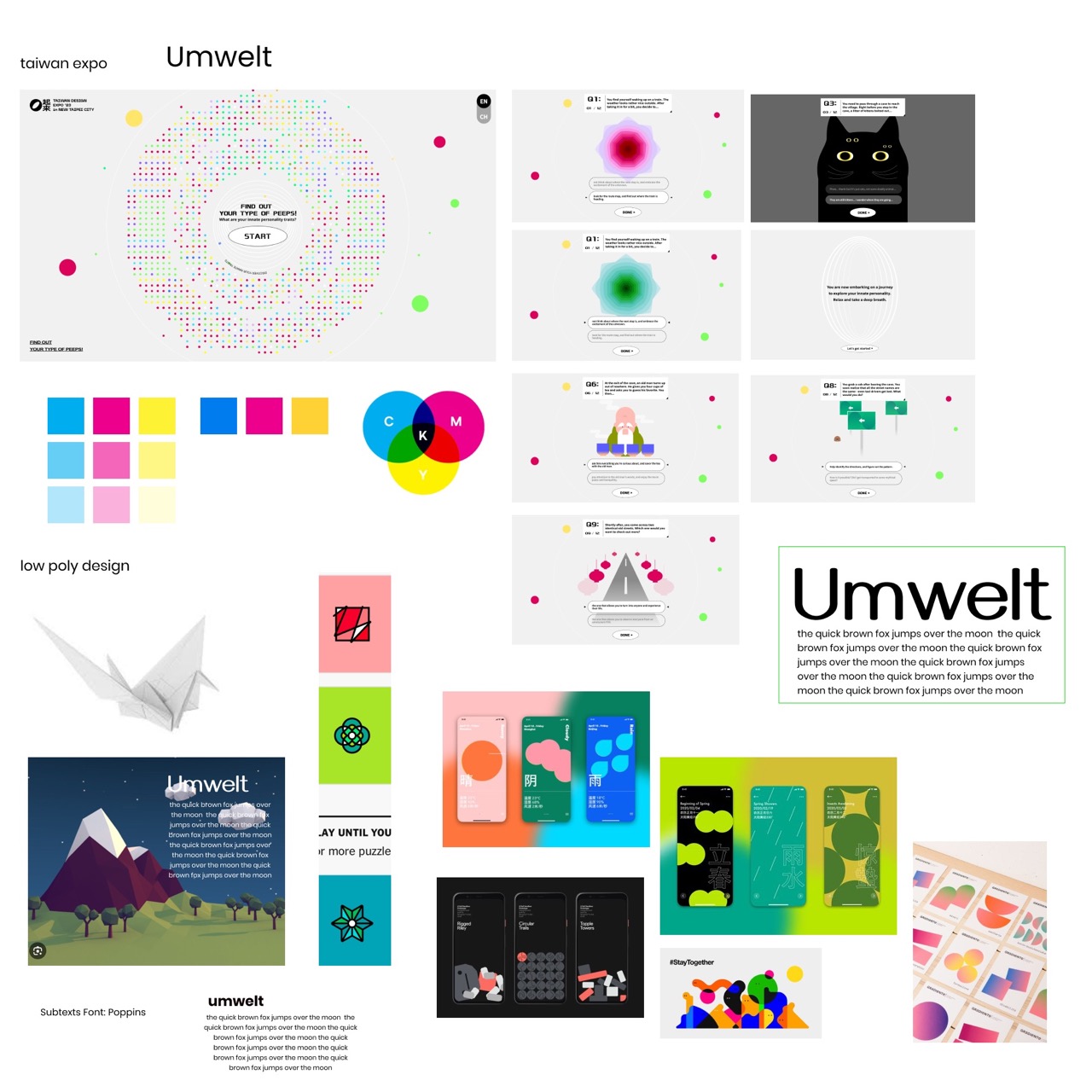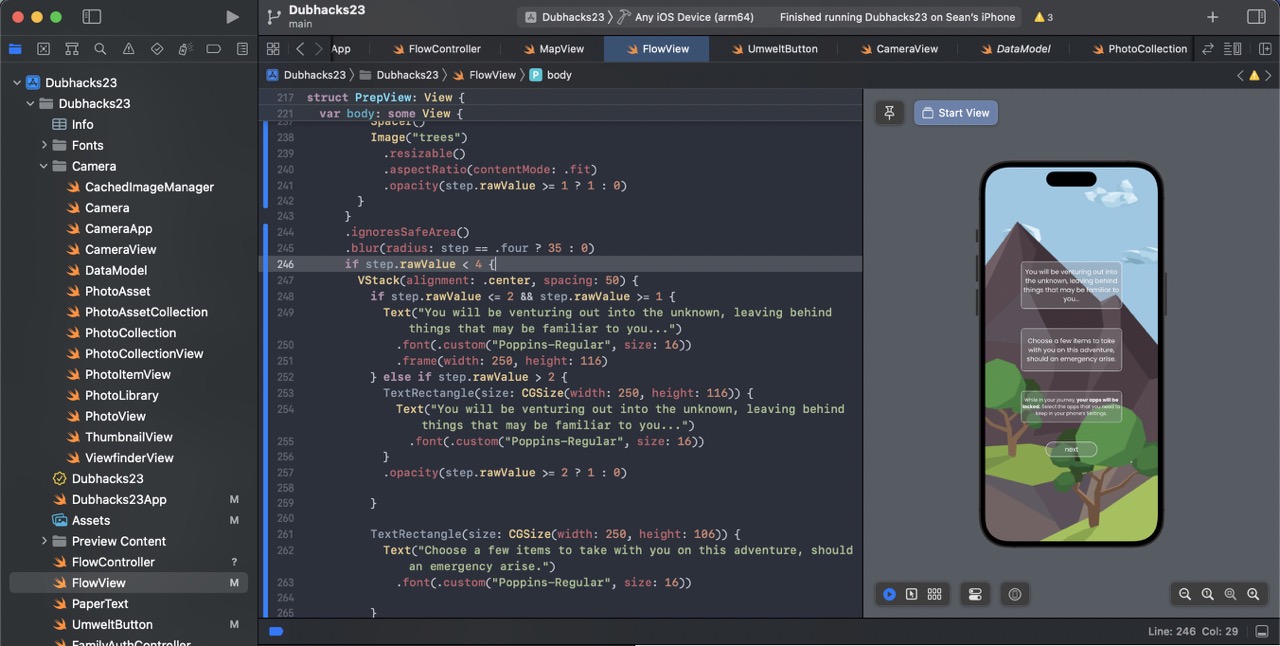
View the project website here — I designed and implemented this website, it was really fun to do these animations with GSAP!
Inspiration
Burnout is a prevalent issue in today’s fast-paced society, as highlighted by Byung-Chul Han in his book The Burnout Society. Burnout is not a medical diagnosis. Rather, it is characterized by intense emotional exhaustion. This is caused by the productivity-focused, auto-exploitative society, as well as the information overload that comes with social media. Space today seems to be less “grounded” and more “virtual”. To combat this, we hope to provide uninterrupted time through Umwelt to help people recenter and revitalize. We provide small milestones for people to accomplish in a gamified manner. We chose walking through nature as an activity due to its accessibility and effectiveness, though, if we had more time, we would like to consider the design question of “how can we accommodate those who are not able-bodied or do not have safe communities to walk in?” Though we recognize that this is a systematic issue, we hope to make incremental changes through micro-interventions like Umwelt.
What it does
Block out distractions with Umwelt and enjoy a hero’s journey through nature. During your walk, you will unlock various encounters in your surroundings. Look out for and capture these moments and absorb the beauty of the spaces around you.
Burnout is the opposite of vitality — it is utter exhaustion. Through Umwelt, we hope to reshape individual perceptions of experiences and reality to revitalize daily life. In doing so, we hope to drive transformation in modern productivity culture and curb the development of a burnout society.
Mission
To revitalize society by finding little moments of magic in nature
Vision
Encouraging sustainable and balanced lifestyles It can be difficult to swim against the currents of social media in an age of constant information overload. With Umwelt, we can embark on an adventure of mindset transformation to move towards a balanced life.
Transforming experiences to enhance our collective vitality
Let’s take a moment to reshape our interactions with the spaces we inhabit to nourish our physical, mental, and spiritual vitality.
Becoming able to simply exist
What does it mean to live a “good” life? Taking a walk in nature is “unproductive” by societal standards, which is precisely why we should do it: to relish in the art of lingering and of simply being.
How we built it
Our team collaborated on the low-fidelity design process, then began to branch off into high-fidelity design (Annie and Stephanie), research and web development (Bella), and iOS development (Sean). Annie and Stephanie worked with Figma and Adobe Illustrator; Bella worked with Next.js, GSAP, SASS, and Bootstrap; and Sean worked with Swift. We maintained open communication and discussion throughout the process to ensure we stayed on the right track and adhered to our initial visions.
Challenges we ran into
As a team, our main challenge was brainstorming ways to use technology to encourage independence from it. For Sean, it was challenging to learn how to use iOS frameworks for the camera and map under time constraints. For Annie and Stephanie, the linear user flow was challenging due to being different from what you’d expect from a typical app.
Accomplishments that we're proud of
This is our first in-person hackathon experience, so we are proud of coming this far under immense time pressure. Our ideation process was highly enjoyable, and we are proud of stepping out of our comfort zones to design an experience rather than a tool. We also figured out our strengths quickly and adapted to fit them into the creation process.
What we learned
So much… The design team learned how to animate boxes, Sean learned iOS animation and frameworks, Bella learned new front-end animation and interaction techniques, and we all learned how to collaborate within a cross-functional team.
What's next for Umwelt
We hope to expand Umwelt further as a personal project. After developing an MVP, we would like to have people test it and start gathering user feedback.
Development report
1. brainstorming
We kicked off our hackathon session by first identifying the track, and then the related problem spaces that we were interested in. We decided to approach vitality from four perspectives: physical, mental, emotional, and spiritual. We realized, however, that many of these areas overlap, and that vitality extends to all areas of life. Our favorite ideas were burnout society, time in nature, and sustainable knowledge, so we discussed these areas more in-depth, then proceeded to research and design.


2. problem space
Burnout is a prevalent issue in today’s fast-paced society, as highlighted by Byung-Chul Han in his book The Burnout Society. Burnout is not a medical diagnosis. Rather, it is characterized by intense emotional exhaustion. This is caused by the productivity-focused, auto-exploitative society, as well as the information overload that comes with social media. Space today seems to be less “grounded” and more “virtual”. To combat this, we hope to provide uninterrupted time through Umwelt to help people recenter and revitalize. We provide small milestones for people to accomplish in a gamified manner, as maps and gamification are proven to be effective design choices to incentivize activity. We chose walking through nature as an activity due to its accessibility and effectiveness, though, if we had more time, we would like to consider the design question of “how can we accommodate those who are not able-bodied or do not have safe communities to walk in?” Though we recognize that this is a systematic issue, we hope to make incremental changes through micro-interventions like Umwelt.
3. process
3.1 design
View our Figma wireframes here
We were inspired by Taiwan Design Expo and other minimalistic, whimsical designs for our branding.

3.2 iOS development
We worked on design and development simultaneously to cover more ground as a team.

annotated bibliography
Key: 💡= applications to our intervention
Powell, K. Work–life balance: Break or burn out. Nature 545, 375–377 (2017). https://doi.org/10.1038/nj7654-375a
- Burnout is not a medical diagnosis
- Overwhelming fatigue
- Loss of motivation
- Chronic stress
- Frustration
- Can lead to depression
- “The type of break doesn’t matter”
Grant, Adam. “Feeling Blah During the Pandemic? It's Called Languishing.” The New York Times, 3 December 2021, https://www.nytimes.com/2021/04/19/well/mind/covid-mental-health-languishing.html.
- Languishing
- Stagnation
- Emptiness
- Mental health as a spectrum from depression to flourishing
- Languishing: middle point, absence of well-being
- Coined by Corey Keyes
- Combat through flow
- Dissolving sense of time, place, and self
- Enjoyable experiences, meaningful work
- Created through focus
- → 💡 Umwelt aims to do this by allowing users to recenter
- Uninterrupted time
- Small goals
- → 💡 Umwelt aims to do this by allowing users to recenter
Danell J. Haines PhD , Liz Davis MA, CPT , Patrice Rancour MS, RN, CS , Marianne Robinson BS, CHES , Trish Neel-Wilson BSN, CDE, CES & Susan Wagner DVM, MS, DACVIM (2007) A Pilot Intervention to Promote Walking and Wellness and to Improve the Health of College Faculty and Staff, Journal of American College Health, 55:4, 219-225, DOI: 10.3200/JACH.55.4.219-225
- Walking can positively impact BMI, blood glucose, and cholesterol levels
- Easy and sustainable way to promote health and well-being
- 💡 Accessible to implement in walkable communities
- Challenge: how can we accommodate for those who are not able-bodied or whose communities are unsafe to walk in?
Craig, Geoffrey, and Wendy Parkins. Slow Living, Bloomsbury Publishing Plc, 2006. ProQuest Ebook Central, https://ebookcentral.proquest.com/lib/washington/detail.action?docID=1643848.
- Space seems less “grounded” and more “virtual”
- "Slow living is not a counter-cultural movement: it does not propose the
establishment of alternative spaces but the transformation of the spaces we
currently inhabit." (62)
- → 💡We aim to reshape our interactions with the spaces in our communities to promote sustainable practices of physical, mental, and spiritual vitality.
- Community spaces in daily life are often taken for granted
- "At the heart of slow living is a certain 'mindful' consciousness where
activities, practices, and encounters are invested with care and attention and
such a consciousness requires particular spatial contexts as much as it
requires a slow temporality." (63)
- “space is a profoundly social phenomenon” (63)
Bo Han (2018) Social Media Burnout: Definition, Measurement Instrument, and Why We Care, Journal of Computer Information Systems, 58:2, 122-130, DOI: 10.1080/08874417.2016.1208064
- Three sub-dimensions of social media burnout
- User’s ambivalence
- Emotional exhaustion
- Depersonalization
- E.g. taking a “Facebook vacation”
- Causes
- Feeling anxious about being overwhelmed by information
- Information and social overload
- Unable to find resolution to mediate pressure
- Hard to escape cycle
- Social media as a complement to offline social networks
- Can overtake in priority
- Expensive termination cost to something that took a long time to build (e.g. online network)
- Social media as a complement to offline social networks
- Hard to escape cycle
- Wanting to disconnect from social media, taking vacations from it
- Feeling anxious about being overwhelmed by information
- Burnout: emotional exhaustion
- Burnout and gratification can co-exist
- → 💡Striking a fine balance by providing gamified, yet mindful breaks
“Let's all get up and walk to the North Pole: design and evaluation of a mobile wellness application.” Proceedings of the 6th Nordic Conference on Human-Computer Interaction: Extending Boundaries, 2010, pp. 3–12, https://dl.acm.org/doi/abs/10.1145/1868914.1868920.